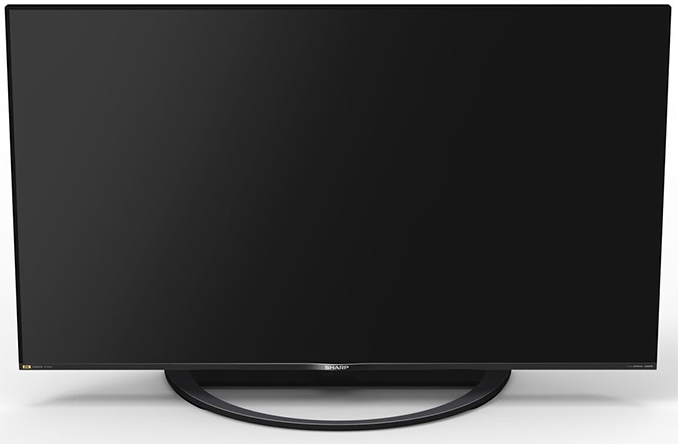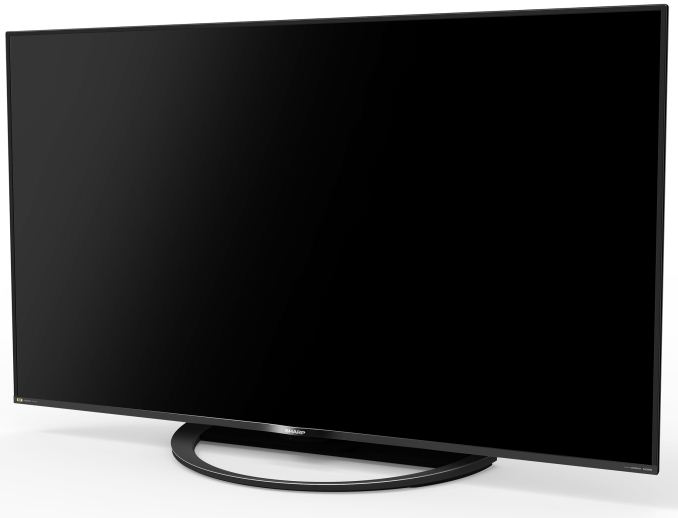Sharp Announces 2nd Gen 8K UHD TVs at IFA
by Anton Shilov on August 31, 2018 11:00 AM EST
Sharp this week introduced its second-generation 8K ultra-high def TVs at IFA in Berlin. The new televisions use the company’s new panels as well as the latest processors that can upscale Full-HD and Ultra-HD 4K content to a 7680×4320 resolution.
The initial lineup of Sharp’s 2nd Gen Aquos 8K UHD TVs will include models featuring sizes of 60, 70, and 80 inches. The new televisions will be based on the company’s new image processor that doubles its compute throughput over the predecessor and can upscale 2K as well as 4K content to an 8K resolution with a 100/120 Hz refresh rate.
The largest Aquos 8T C80AX1 80-inch flagship TV will rely on the company’s new UV2A II LCD (presumably IPS/IGZO) panel featuring a 100/120 Hz refresh rate, an “ultra-high brightness”, a “new wide color gamut”, and “high speed response”. The company does not quantify its claims, but it is logical to expect the new TV to be better than the existing Sharp Aquos LC-70X500E UHD TV that features a 400 nits typical brightness, a 1000 nits peak brightness for HDR (HDR10, HLG are supported), and an 8 ms GtG response time. Meanwhile, it is unclear whether a wider color gamut means a better coverage for the BT.2020 color gamut by a new 10-bit panel, or usage of a 12-bit panel.
Sharp plans to commercially launch its Aquos AX1-series 8K UHD TVs in Asia in late 2018 with European release sometimes in Q1 2019. The manufacturer said nothing about availability of its 2nd Gen 8K UHD TVs in the U.S., but since it calls the new family a “global 8K lineup”, it is logical to assume that the televisions will eventually be available in North America as well.
Related Reading:
- Sharp’s 8K UHD TV Available in Japan, Listed in Europe for €11,899
- CEATEC 2016: Sharp Showcases 27-inch 8K 120Hz IGZO Monitor with HDR, also 1000 PPI for VR
- Foxconn Takes Control of Sharp
Sources: Sharp, Technite-Video.de











49 Comments
View All Comments
Senectus - Monday, September 3, 2018 - link
I'm planning on getting an 86" 4K TV for my new apartment and the living room isn't really all that big. If only I could afford a 100"+ TV, I would get it and it would probably fit just fine. :)When you go to the cinema and look at the screen, it will typically fill your entire field of view - which is great for immersion and I haven't heard anyone complaining that cinema screens are too large. In fact, everybody loves a classic IMAX theatre.
But then for some reason, the majority of people get TVs that are significantly undersized for their rooms and the distance they would be viewing from, yet they're fine with them.
Now, I understand that large TVs are an expensive luxury and not everybody can afford one, but what I don't understand are the typical rationalisations such as that a large TV is pointless unless your living room is the size of a football field and you're sitting a hundred meters away from the TV.
An 80" screen won't even fill your entire field of view when sitting just 2m away from it (and the sofa in most living rooms that I've been to has been further away than that), so TVs can grow even more beyond the current sizes that are commonly deemed as being too large today. Just look at the history of TV sizes and what was considered as "humongous" just a decade or two ago is now just considered as mediocre or even small.
lothar98 - Tuesday, September 4, 2018 - link
But then for some reason, the majority of people get TVs that are significantly undersized for their rooms and the distance they would be viewing from, yet they're fine with them.That part made me laugh. Only one time in my life has my wife said I got a TV that was too small. I bet I am in the minority with that.
Manch - Tuesday, September 4, 2018 - link
Wouldnt 4 23" 1080p monitors be a 46" 4K?Senectus - Tuesday, September 4, 2018 - link
Yes, 4x23" 1080p monitors would be 46" 4K, however at only standard (legacy) 96 DPI.46" 8K would still give you the same working area/physical size of UI on the screen as that of 96 DPI, but at double the sharpness/clarity with 192 DPI - i.e HiDPI/Retina.
This is perfect pixel doubling on both axes i.e 200% scaling, where one physical pixel on the legacy 96 DPI will be drawn by 4 smaller pixels on 192 DPI.
Manch - Wednesday, September 5, 2018 - link
Ah OK, gotcha. Yeah I could see how that would be nice. I just replaced my 3 24" monitors with a 50" 4k. kept the pixel pitch relatively the same.Oxford Guy - Monday, September 3, 2018 - link
"Meanwhile, it is unclear whether a wider color gamut means a better coverage for the BT.2020 color gamut by a new 10-bit panel, or usage of a 12-bit panel."The bits for processing does not really mean gamut. It means the resistance to banding. Yes, more colors are technically available with less banding but the actual gamut (the color space) can be small even with 12-bit processing. It's just finer gradations of a smaller overall space.
One could have 32-bit processing within the very small sRGB color space, for instance.
Oxford Guy - Monday, September 3, 2018 - link
Yay! 8K! Just what absolutely no consumer needs in a television.(used as a television, not a monitor sitting really close)
twtech - Tuesday, September 4, 2018 - link
Too small for 8k. They should work on manstreaming TVs over 100" first, and then they'll have a market for 8k.V900 - Tuesday, September 4, 2018 - link
I’d love to know what kind of obscene hardware it uses, in order to upscale to 8K/120 Hz?!?